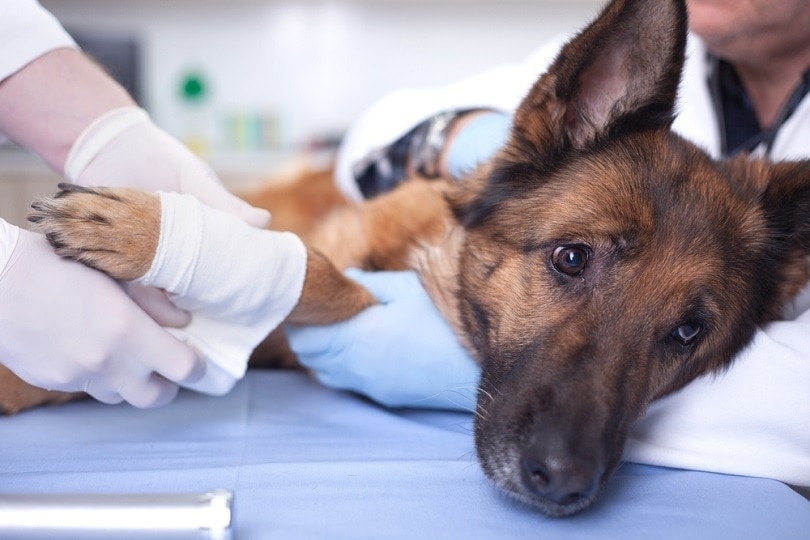In this article
Whether it’s from a tumble in the park, a bad stumble, or seemingly nowhere at all, a limp is never good news. If your dog seems to be in pain from an injured leg, your first thought might be a sprained ankle or a broken bone. But ligament damage is a common—and dangerous—injury as well.
And unfortunately, ACL surgery is usually on the pricier side. Costs vary depending on your vet and the type of injury, usually coming in at around $2,000–$4,000 on average. Unfortunately, these surgeries are often the only way to treat a torn ACL.

What Is ACL/CCL Surgery?
Canine ACL surgery is actually a misleading name. In humans, the ACL is a ligament that holds your knee in place. ACL tears aren’t uncommon among athletes, so the concept of ACL surgery is familiar to a lot of us. Even vets often call the surgery an ACL surgery when speaking to owners. But it’s worth noting that in dogs, the equivalent ligaments are actually called CCLs—which stands for cranial cruciate ligament.
There is also a second ligament in the back of the knee called the caudal cruciate ligament. Injuries to the caudal cruciate ligament are much rarer, but sometimes vets will lump both types of injuries together because they require similar surgeries.

How Much Does Dog ACL Surgery Cost?
The overall cost of ACL surgery can vary a lot, and the biggest factor is the type of repair attempted. There are several ways to repair a torn ACL, each with its own benefits and drawbacks. Here are the most common types of surgeries.
Lateral Suture Technique (ECLS)
- Cost: $750–$2,000
In lateral suture repair surgery, synthetic material is attached to the outside of the knee joint to act as a manmade ligament.
This is often the simplest and cheapest repair technique, but it might lead to long-term stiffness or a loss of range of movement. It’s also often not suitable for dogs over 40 pounds or highly active dogs, although some variations of the technique show promising results.
TightRope Technique
- Cost: $1,000–$2,000
The tightrope technique is a similar technique, but instead of just attaching a synthetic ligament to the outside of the knee, holes are drilled through the bones, and a loop of synthetic material is used.
This technique is very similar in success and recovery rates, and it also works best on smaller and less active dogs. It also generally isn’t used on dogs who have previously torn their CCL.

Tibial Plateau Leveling Osteotomy (TPLO)
- Cost: $2,000–$6,000
Tibial Plateau Leveling Osteotomy is a completely different technique. Instead of replacing the ligament with a synthetic alternative, TPLO cuts into the bones, changing the shape of the joint so that it’s more stable. Imagine that the ligament is like a rope that stops a cart from rolling down a hill. ECLS and TightRope surgeries are like repairing the broken rope—TPLO is like moving the wagon to flatter ground instead.
The biggest advantage of TPLO is that it’s extremely stable. That makes it great for large dogs, athletic dogs, and dogs who have already had past CCL injuries. Unfortunately, it’s also a much more invasive surgery option. That means that it’s much more expensive. It can also mean that recovery times are longer.
Tibial Tuberosity Advancement (TTA)
- Cost: $3,000–$6,000
Tibial Tuberosity Advancement (TTA) surgeries are a cousin to TPLO surgeries. In this surgery, after cutting into the bone to change the joint shape, a spacer and a metal plate are added to help stabilize the joint.
TTA surgeries carry the same advantages and drawbacks as TPLO surgeries, but they work better for dogs with a specific shape of joint. Like TPLO, these surgeries can be very expensive.

Additional Costs to Anticipate
In addition to the cost of the surgery itself, there are several other expenses to consider. The cost of surgery listed above doesn’t include any diagnostic testing, such as a vet exam or an X-ray. It also doesn’t include the costs of pain medication, which might be needed before and after surgery.
Post-surgery care can be a long road, with several follow-up visits and possibly rehabilitative training and exercises required. In some cases, a dedicated physical therapist will be necessary to help with rehabilitation.
Another cost to anticipate is further injury. Dogs who have had one torn CCL are much more likely to have a second tear in the other leg in the future. The extra stress put on the uninjured leg during recovery often causes damage to the ligaments, making a second injury more likely. Because of this, it’s important to prepare for future surgeries, just in case.
Recovery From Dog ACL Surgery
After surgery, you shouldn’t expect your dog to be back to its normal self right away. In fact, the full recovery process may take as long as 6 months!
During the first one or two weeks after the surgery, your dog will need to be put on crate rest, spending most of the day in a space with only enough room to stand up and turn around. A cone or similar collar will help prevent your dog from damaging the stitches until they heal.
After your dog is cleared from crate rest, you’ll still need to prevent it from running, jumping, climbing stairs, and other activities that might lead to injury until your vet okays it. This might last for as long as a few months. During this time, your dog might feel perfectly fine and not understand why it can’t run and jump like before, but it’s important to wait until full recovery anyway.
In some cases, further physical therapy might be needed to help your dog recover normally. This might include specific exercises that you help your dog do at home or meeting with a dedicated therapist to help your dog heal properly.

Is Surgery Always Needed?
Surgery is generally recommended for a torn CCL. Without surgery, the chances of your dog regaining normal leg function are very low, while surgery often has success rates of over 90% for regaining the majority of function and relieving pain.
However, some vets do not recommend surgery for senior dogs or dogs with other health conditions that would make surgery more dangerous and less likely to be successful. In these cases, pain management is the most common path forward. Crate rest might allow some healing to take place, and a combination of medication and reduced activity will help alleviate pain.
Does Pet Insurance Cover Dog ACL Surgery?
Now, here’s the good news—many pet insurance companies generally cover this surgery. Because a torn CCL is usually the result of an injury, it’s usually pretty easy to get insurance to cover their share. Depending on your insurance, anywhere from 50% to 100% of the costs might be covered. Diagnostic tests and recovery-related expenses might or might not be covered depending on your plan.
It’s important to be in contact with your insurance when planning surgery to make sure that any requirements for coverage are taken care of. It’s also important to be aware of any maximum payout amounts or other restrictions that might apply to this surgery and related care.

Conclusion
As you can see, ACL surgery is not a minor event. This surgery is involved and can be costly, especially without insurance. However, it is also usually successful, and your dog has an excellent chance of returning to normal after surgery.
Whatever type of surgery your vet recommends, we hope that this explanation of the options and costs involved can help you make the best choice for your pet.
See also:
Featured Image Credit: VP Photo Studio, Shutterstock


















